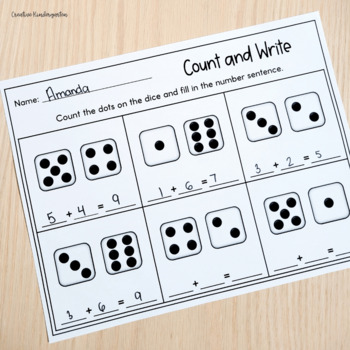

Their score for the round is the difference between 20 and their number, with the goal being the lowest score possible. They then turn each into a two-digit number and add or subtract, with the goal of a sum or difference as close to 20 as possible. In this Dice in Dice game, players roll two dice cubes.

KINDERGARTEN MATH GAMES WITH DICE HOW TO
This area and perimeter activity is even more fun as a Dice in Dice game! Learn how to play at Teaching With Jillian Starr. Get a printable game board to use at Classroom Games/Activities. The trick? They can only use each operation once, except for one “Free Choice” option. The result is their score for each round. For each round, a student rolls the double dice cube and decides whether they want to add, subtract, multiply, or divide the numbers.

There are five rounds in this Dice in Dice game. This will give them work with negative numbers.
KINDERGARTEN MATH GAMES WITH DICE FREE
Snag a free printable multiplication practice sheet from Life Over C’s.īonus Tip: For more advanced subtraction practice, have students subtract the inside die from the outside die, no matter which number is greater. Simply roll a double dice cube, then add, subtract, or multiply the numbers depending on what you’re practicing. Practicing math facts is a lot more fun with Dice in Dice games. Get a free recording sheet to use with Dice in Dice games of comparison at Positively Learning. There will be a temptation for some kids to think the number on the outside larger die is always “bigger,” so they’ll have to really think about their answer. Work on comparing numbers.ĭice in Dice present a surprising twist when teaching kids to compare numbers. (Play with 10-sided dice to work on addition facts up to 20.) 5. The goal is to be the first to cross off all the numbers, 2-12. If the number has already been crossed off, they simply pass the cube on. They cross that sum off their sheet, and the next player goes.

On each turn, a student rolls a double dice cube and adds the two numbers. The kindergarten Dice in Dice games version is simple: Each player writes the numbers 2-12 on a piece of paper (or get free printable sheet at Kids Count). Grown-up Yahtzee requires six dice and is a bit complex for little ones. Play continues and the first to make it to 100 wins! Learn more from Shelley Gray. They continue writing until the next player rolls doubles, then stop as the the second player takes the pencil and starts writing their own list. At this point, they pass the cube to the next player and start writing numbers from one to 100 (or any target number you like). The first player rolls the Dice in Dice cube repeatedly until they roll doubles. This dice in dice game is terrific for giving kids practice writing numbers. For the dice shown here, the student would say, “5…6, 7, 8, 9, 10.” 2. Kids start with the number on the larger die, counting on as many as the number on the inside smaller cube. Practice counting on.Ĭounting on helps get kids ready for addition, and double dice games are perfect for some practice! Roll a Dice in Dice cube. We earn a few cents if you buy using our links, at no additional cost to you. We’ve gathered the top 12 clever uses here.īut first … need some double dice of your own? Here are a few of our favorite options: These cool double dice have one small die inside a transparent larger one, and there are so many fun ways to use them in the classroom. When Leigh isn’t teaching or writing for her teacher blog, The Applicious Teacher, she enjoys snuggling up with a good book, running a few miles, or spending time with her family.Dice in Dice were the most popular item purchased by WeAreTeachers readers last month, and it’s easy to see why. She currently resides in Central Florida where she has been teaching for 7 years. Leigh is a wife, mother, and a second-grade- turned-third-grade teacher. So go forth and play! Get your students engaged and learning in the new year! If you’re not sure you’ll remember all these games I shared today, I’ve compiled all the directions in one file for you. I find this game works best in math centers and is an easy way for students to practice their math facts in a new and unique way! The student depending on the flashcards you are using. Students play until all the cards are won. If students have the same answer, then they play each other again, with the winner capturing all the cards in play. This can be modified to lowest difference or quotient. The card with the highest sum or product wins all the cards in play. Then, on the count of three, all students throw down a card. To play, students divide the flash cards evenly among all players.


 0 kommentar(er)
0 kommentar(er)
